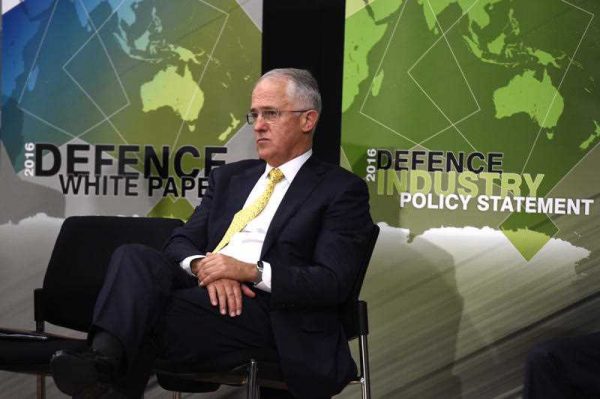Still, some — most notably Hugh White — would describe the new White Paper as ‘hidebound’, arguing DWP16 makes misplaced calls for the US-led international order to be maintained at any cost. This view holds that US military power is no longer sufficient to resist the major challenges to America’s global primacy and ‘the rules-based global order’ in Australia’s neighbourhood.
This line of reasoning has a catchy resonance, suggesting the writers of DWP16 just don’t get the message about the so-called ‘China Choice’. Painting the strategic setting in stark colours that are evocative and confronting serves a purpose. It challenges pundits to reflect on whether their assumptions are valid.
But a dark and sinister interpretation of the strategic setting is an overstatement and too binary to be realistic. Reducing the government’s choices to unduly stark alternatives misses significant aspects of a complex picture — a picture which calls for more nuanced policy options in response. Claims that DWP16 seeks to preserve the regional order ‘unchanged’ belie the considerable space allocated in DWP16 to engaging with China. This is despite China’s evident and largely unwelcome assertive behaviour in the South China Sea and elsewhere, notably in cyberspace. These have had the combined effect of challenging the limits of US power in Asia.
Successive defence white papers have recognised the limits of the US alliance and of the need for Australia to maintain a defence force with a degree of self-reliance. The term ‘self-reliance’, in use since the 1976 Defence White Paper, admittedly, does not feature as frequently as in earlier editions. But the essence of the concept remains as strong if not stronger, through the 2016 document’s emphasis on improving ties with neighbouring states. Reflecting on the importance of regional security ties for a self-reliant posture to be effective, DWP16 calls for greater engagement with the member states of ASEAN, as well as with other regional powers like South Korea, Japan and India.
DWP16 advocates the security ties with a spectrum of these regional countries and, in referring to increased ‘international engagement’, points to areas for further collaboration. The regional powers listed for closer engagement understand that China is asserting itself in ways that makes them uncomfortable and they therefore look to each other — but more importantly to the United States — to remain closely engaged in regional security affairs as a counterweight.
Still they seek to avoid making commitments that would precipitate a confrontation or unduly narrow their strategic choices in the future. Australia similarly seeks to support the American military presence in the neighbourhood while engaging as broadly and deeply as possible with other regional powers.
Some make confident pronouncements about the future. But in seeking to plan for and map out key capability options, DWP16 grapples with the fundamental truth that the future is unknowable. China itself faces significant choices, as do all the other regional players. Those choices do not all revolve exclusively around whether the US-led global order is being ‘replaced’. After all, China’s economic, political and strategic prospects are as subject to fluctuations as are the prospects of other powers.
China is one of the leading beneficiaries of the established order. It has gained greatly from the peace and stability of which the United States has been guarantor, and from the US-influenced world trading system. While there is debate about China’s intentions, China appears to understand the need to be relatively circumspect, exercising coercion but without pushing the United States or its security partners over the threshold of open conflict.
When uncertainty about the future is combined with heightened concerns about China’s growing assertiveness militarily and otherwise (notably with white painted ships in the South China Sea and through cyberspace), there is an understandable call in DWP16 for balanced capability options for a spectrum of plausible scenarios that might arise in the next few decades.
Unlike the previous Defence White Paper of 2013, this one provides detailed and endorsed costings and timetables for capabilities to be delivered in the next two decades. To be sure, governments can choose to recant. But at the moment this funding commitment has bipartisan support. Nothing is certain, and well planned funding commitments have been hollowed out repeatedly in the past, but this provides more certainty for funding than has been evident for many years.
There are those who would argue that Australia (and presumably other regional powers) have to choose a different course to that outlined in DWP16. The alternative choices are rarely articulated in stark terms, but in essence they appear to revolve around abandoning or significantly decreasing Australia’s commitment to the US alliance. The choice then would be to increase defence spending dramatically, or alternatively to reduce defence expenditure significantly — and in effect decide to accept unreservedly China’s apparent ambitions in East and Southeast Asia, in cyber space, and around Australia.
One day there may be an appetite for doubling or tripling Australia’s defence expenditure to allow for more independence. But that time is not likely anytime soon. Cutting back on defence expenditure and on ties with the United States is an option that is politically and strategically untenable for Australia and for other regional powers. In the end, what choice does Australia really have other than that outlined in DWP16?
John Blaxland is Senior Fellow at the Strategic and Defence Studies Centre, The Australian National University.


In terms of sheer size, the US, China and Russia are whales. Japan is a shark and Australia is a giant tuna.
When a Third World War starts, especially if it is a nuclear war, the shark and the giant tuna will be destroyed, together with the whales.
Is a Third World World on the way? Yes, according to Australia’s visionary John Pilger.